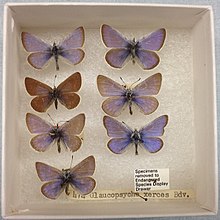
The monarch butterfly or simply monarch is a milkweed butterfly in the family Nymphalidae. Other common names, depending on region, include milkweed, common tiger, wanderer, and black-veined brown. It is among the most familiar of North American butterflies and an iconic pollinator, although it is not an especially effective pollinator of milkweeds. Its wings feature an easily recognizable black, orange, and white pattern, with a wingspan of 8.9–10.2 cm (3.5–4.0 in). A Müllerian mimic, the viceroy butterfly, is similar in color and pattern, but is markedly smaller and has an extra black stripe across each hindwing.

Asclepias syriaca, commonly called common milkweed, butterfly flower, silkweed, silky swallow-wort, and Virginia silkweed, is a species of flowering plant. It is native to southern Canada and much of the United States east of the Rocky Mountains, excluding the drier parts of the prairies. It is in the genus Asclepias, the milkweeds. It grows in sandy soils as well as other kinds of soils in sunny areas.

Asclepias incarnata, the swamp milkweed, rose milkweed, rose milkflower, swamp silkweed, or white Indian hemp, is a herbaceous perennial plant species native to North America. It grows in damp through wet soils and also is cultivated as a garden plant for its flowers, which attract butterflies and other pollinators with nectar. Like most other milkweeds, it has latex containing toxic chemicals, a characteristic that repels insects and other herbivorous animals.

Robert Michael Pyle is an American lepidopterist, writer, teacher, and founder of the Xerces Society for Invertebrate Conservation. Much of his life story is told in the 2020 feature film The Dark Divide, where Pyle is played by David Cross.
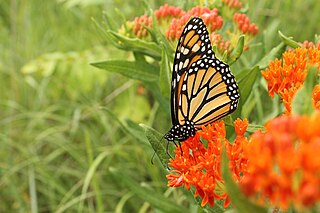
Butterfly gardening is a way to create, improve, and maintain habitat for lepidopterans including butterflies, skippers, and moths. Butterflies have four distinct life stages—egg, larva, chrysalis, and adult. In order to support and sustain butterfly populations, an ideal butterfly garden contains habitat for each life stage.
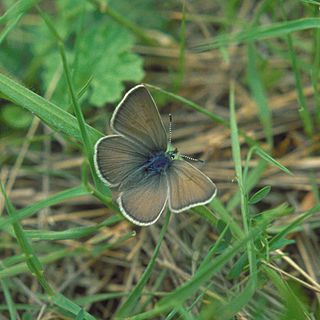
Fender's blue butterfly is a subspecies of Boisduval's blue endemic to the Willamette Valley of northwestern Oregon, United States. The potential range of the butterfly extends from south and west of Portland, OR to south of Eugene, OR. The butterfly is host-specific on the Kincaid's lupine, which it relies on for reproduction and growth. The male and female can be identified by their difference in wing color. The Fender's Blue Butterfly was added to the endangered species list in January 2000, but as of February of 2023, has been reclassified as "threatened". The Fender's blue butterfly population has increased over the past 20 years and projected to increase more through conservation efforts. In Willamette Valley, Oregon, there are currently 90 sites filled with Fender's blue.

In biogeography, a native species is indigenous to a given region or ecosystem if its presence in that region is the result of only local natural evolution during history. The term is equivalent to the concept of indigenous or autochthonous species. A wild organism is known as an introduced species within the regions where it was anthropogenically introduced. If an introduced species causes substantial ecological, environmental, and/or economic damage, it may be regarded more specifically as an invasive species.

Senna hebecarpa, with the common names American senna and wild senna, is a species of legume native to eastern North America.

Asclepias speciosa is a milky-sapped perennial plant in the dogbane family (Apocynaceae), known commonly as the showy milkweed and is found in the western half of North America.
The Pollinator Partnership or P2 is a 501(c)(3) nonprofit organization with its headquarters in San Francisco, California that works to protect the health of managed and native pollinating animals that are vital to wildland and agricultural ecosystems. The Pollinator Partnership’s mission of environmental stewardship and pollinator protection is achieved through conservation, policy, education, and research. Signature initiatives include the NAPPC, National Pollinator Week, and EcoRegional Planting Guides that allow local citizens to plant gardens that provide habitats for important pollinating species.

Bombus occidentalis, the western bumblebee, is one of around 30 bumblebee species present in the western United States and western Canada. A recent review of all of its close relatives worldwide appears to have confirmed its status as a separate species.

Asclepias viridis is a species of milkweed, a plant in the dogbane family known by the common names green milkweed, green antelopehorn and spider milkweed. The Latin word viridis means green. The plant is native to the midwestern, south central and southeastern United States, as well as to the southeastern portion of the western United States.

Franklin's bumblebee is one of the most narrowly distributed bumblebee species, making it a critically endangered bee of the western United States. It lives only in a 190-by-70-mile area in southern Oregon and northern California, between the Coast and Sierra-Cascade mountain ranges. It was last seen in 2006. Franklin's bumblebee collects nectar and pollen from several wildflowers, such as lupine, California poppy, and horsemint, which causes it to be classified as a generalist forager.
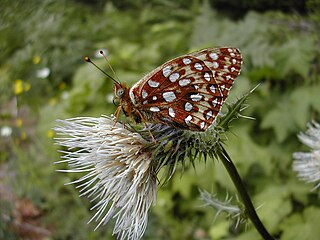
Speyeria zerene hippolyta, the Oregon silverspot, is a threatened butterfly that is found in the U.S. states of California and Oregon. It is a subspecies of Speyeria zerene.
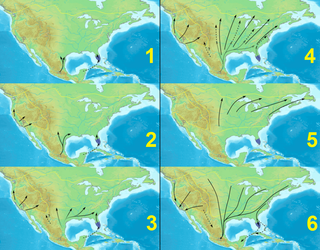
Monarch butterfly migration is the phenomenon, mainly across North America, where the subspecies Danaus plexippus plexippus migrates each summer and autumn to and from overwintering sites on the West Coast of California or mountainous sites in Central Mexico. Other subspecies perform minor migrations or none at all. This massive movement of butterflies has been called "one of the most spectacular natural phenomena in the world".
The U.S. state of California has instituted numerous conservation programs, policies, laws, reserves and Habitat restoration projects throughout the state to facilitate the health and migration of the western population of the monarch butterfly. The population of western monarchs require very different breeding and overwintering habitat when compared to the eastern population of monarch butterflies. They require specific micro-climatic conditions to survive the winter and they are sensitive to habitat changes at the overwintering sites. The large aggregations of butterflies are seen as the most vulnerable at their overwintering locations along the coast. Many monarch overwintering sites are contained within the "coastal zone"; an area defined by the Coastal Zone Management Act to be 1000 yards inland from the high tide mark. Large number of overwintering sites are outside the coastal zone. There are more than 450 overwintering sites in California.
In 1970 California became one of the first states in the U.S. to implement an act that conserves and protects endangered species and their environments. The California Endangered Species Act (CESA) declares that "all native species of fishes, amphibians, reptiles, birds, mammals, and plants, and their habitats, threatened with extinction and those experiencing a significant decline which, if not halted, would lead to a threatened or endangered designation, will be protected or preserved."

Bombus crotchii, commonly called Crotch's bumblebee, is a species of bumblebee named after the entomologist George Robert Crotch. It is classified as endangered due to the impacts of pesticides, climate change, and human development.
Brickellia mosieri, the Florida brickell-bush, is a North American herbaceous plant in the family Asteraceae. It grows in Pine Rocklands in Florida, preferring low-nutrient sand close to sea level. It is characterized by small, round, rod-shaped flowers that are either brown or white. Since 1999, the total population of the Florida brickell-bush has declined by 50% due to a number of threats. Currently, it is listed as "endangered wherever found" under the ESA

A pollinator garden is a type of garden designed with the intent of growing specific nectar and pollen-producing plants, in a way that attracts pollinating insects known as pollinators. Pollinators aid in the production of one out of every three bites of food consumed by humans, and pollinator gardens are a way to offer support for these species. In order for a garden to be considered a pollinator garden, it should provide various nectar producing flowers, shelter or shelter-providing plants for pollinators, and avoid the use of pesticides.

